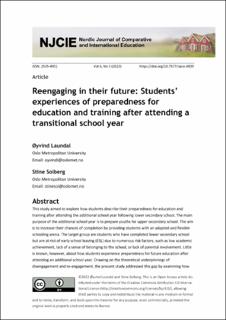Reengaging in their future. Students’ experiences of preparedness for education and training after attending a transitional school year.
Peer reviewed, Journal article
Published version
Permanent lenke
https://hdl.handle.net/11250/3040478Utgivelsesdato
2022-11-14Metadata
Vis full innførselSamlinger
Originalversjon
https://doi.org/10.7577/njcie.4839Sammendrag
This study aimed to explore how students describe their preparedness for education and training after attending the additional school year following lower secondary school. The main purpose of the additional school year is to prepare youths for upper secondary school. The aim is to increase their chances of completion by providing students with an adapted and flexible schooling arena. The target group are students who have completed lower secondary school but are at risk of early school leaving (ESL) due to numerous risk factors, such as low academic achievement, lack of a sense of belonging to the school, or lack of parental involvement. Little is known, however, about how students experience preparedness for future education after attending an additional school year. Drawing on the theoretical underpinnings of disengagement and re-engagement, the present study addressed this gap by examining how 17 youths (age 16) attending the additional school year experienced readiness for future education and training. Data comprised individual interviews with youths in the target group. The reflexive and thematic approach to analysis indicated that students’ experiences of preparedness were characterized by a process of re-engagement in the present and for the future, including social, academic, and practical preparedness. Preparedness is discussed as many-faceted, intertwined with affordances of alternative schooling, and a process of re-engagement. Implications for alternative and conventional schooling are discussed.

